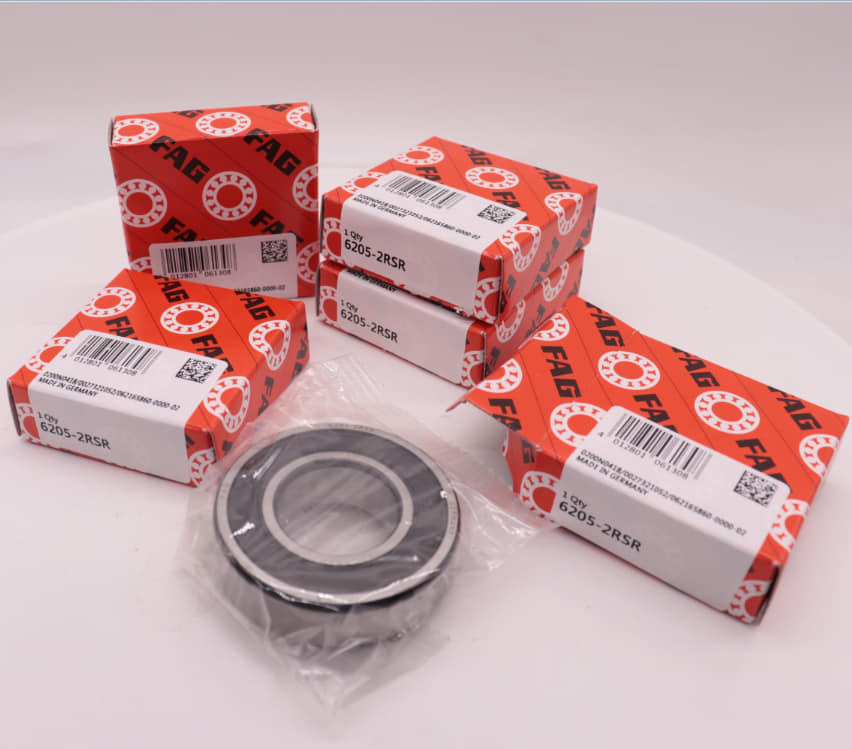
 News
NewsIn the manufacturing process of bearing parts, forging, rolling, punching, turning, grinding, heat treatment and other processes are required, and various defects may occur. Common defects are as follows:
一. Forging defects
1. Forged folding
Due to uneven cutting, burrs, flashing, etc., it is easy to form folds on the surface, which is characterized by thicker folds, irregular shapes, and easy to appear on the surface of parts.
It is best to use fluorescent magnetic powder for flaw detection to make the defect display clearer and more intuitive. Forged and folded magnetic marks are generally linear, grooved, and fish-scale at a certain angle to the surface.
The defect section was made into a metallographic sample and observed under a microscope, the defect tail was round and blunt, both sides were smooth, there was obvious oxidation, and no foreign matter distribution such as material inclusions was found in the defect.
After cold acid corrosion of the metallographic sample, it was observed that there was severe decarburization and oxidation at the defect site and both sides; the surface morphology of the defect layer was observed, and the plastic deformation marks were obvious, and there was no tear-like fracture morphology. After micro-hardness testing and metallographic observation, there are different degrees of carburization and hardening on the surface of the defect layer.
Based on the above analysis, it is shown that the defect should exist before the heat treatment and quenching, and it should be connected to the outside world, and the defect is judged to be forging folding.Eric Bearing has FAG Bearing 6219 in stock, click here for more details.

2. Forged and burned
The forging heating temperature is too high, and the holding time is too long to produce overheating, and the grain boundary oxidizes or even melts in severe cases.
Microscopic observation not only showed sharp corners of surface layer metal grain boundaries being oxidized and cracked; moreover, the grain boundaries began to melt in areas where the internal components of the metal were more severely segregated, and sharp cavities were formed in severe cases.
The burnt material is forged in this defect state, and is forged, punched and rolled by a heavy hammer. The defect will be torn here, forming a larger defect. Forging severely burnt surface morphology such as orange peel, with small cracks and thick oxide scale distributed on it.
Fluorescent magnetic powder should be used for flaw detection to make the defect display clearer. Pocked holes are caused by forging defects.
Observe the metallographic sample along the defect section and observe it under a microscope. It can be seen that the holes are distributed on the surface and the subsurface, and the parts are sharp, different in size, deep and not bottomed, with small cracks on the edge, and some areas have appeared. Grain boundary oxidation phenomenon, with pore morphology. After smashing the fracture along the defect hole and observing the fracture surface, it can be seen that the fracture is a stone-shaped fracture with a large number of holes and micro cracks distributed on it.
二. Quenching crack
In the quenching process, when the quenching temperature is too high or the cooling rate is too fast, and the internal stress is greater than the fracture strength of the material, quenching cracks will appear.
It is advisable to use fluorescent magnetic particle inspection to improve sensitivity and reliability. The magnetic traces of quenching defects are generally oblique, arc-shaped, dendritic or network-shaped, with a wide starting position and gradually becoming thinner with the extension direction.
Basically distributed along the circumferential direction, the tail is tapered. After cutting the cracks to make a metallographic sample, it can be seen that the cracks are very deep, basically perpendicular to the outer surface, and no foreign matter distribution such as material inclusions is found inside. Observed after smashing the fracture along the crack, the fracture is brittle, and the fracture surface has obvious tempering color.FAG Bearing 3322M online, contact us for more information.
三. Grinding defects
In the grinding process of bearing parts, due to the excessive feed rate of the grinding wheel, the beating of the grinding wheel shaft, the insufficient supply of cutting fluid and the blunt grinding wheel abrasive particles, etc., grinding cracks are easily generated in the parts. In addition, the quenching temperature is too high during the heat treatment, which causes the structure of the parts to be overheated, the grains are coarse, the amount of retained austenite is large, and there are nets and coarse particles.
The magnetic marks of grinding defects are generally in the form of nets, radials, parallel lines or cracks. The magnetic marks are thin and sharp, with clear outlines and large numbers, usually perpendicular to the grinding direction. The magnetic marks are mostly concentrated in the middle part, along the circumferential direction, in a long line or branch shape, with partial branches, and the magnetic marks converge.
Observation after taking the metallographic sample of the crack section, the crack is relatively fine, perpendicular to the surface, and there is no distribution of foreign matter such as material inclusions and oxide scale.
四. Raw material defects
The magnetic marks of grinding defects are generally in the form of nets, radials, parallel lines or cracks. The magnetic marks are thin and sharp, with clear outlines and large numbers, usually perpendicular to the grinding direction. The magnetic marks are mostly concentrated in the middle part, along the circumferential direction, in a long line or branch shape, with partial branches, and the magnetic marks converge.
Eric Bearing Limited has over 10 years' experience of exporting Bearings. Welcome every customer to contact us to establish a long-term cooperative relationship. Our company only provide the best high-quality brand bearings.